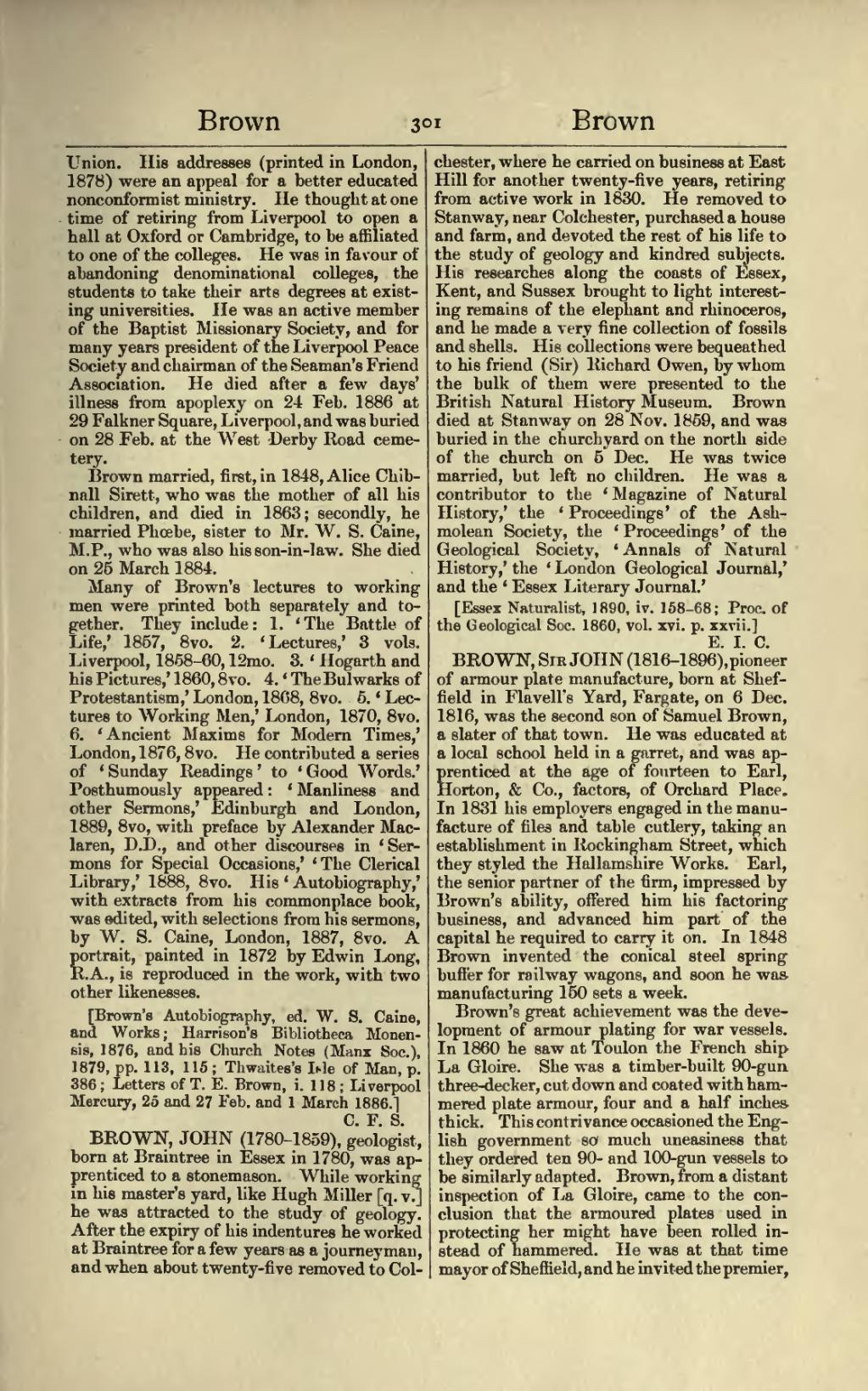Union. His addresses (printed in London, 1878) were an appeal for a better educated nonconformist ministry. He thought at one time of retiring from Liverpool to open a hall at Oxford or Cambridge, to be affiliated to one of the colleges. He was in favour of abandoning denominational colleges, the students to take their arts degrees at existing universities. He was an active member of the Baptist Missionary Society, and for many years president of the Liverpool Peace Society and chairman of the Seaman's Friend Association. He died after a few days' illness from apoplexy on 24 Feb. 1886 at 29 Falkner Square, Liverpool, and was buried on 28 Feb. at the West Derby Road cemetery.
Brown married, first, in 1848, Alice Chibnall Sirett, who was the mother of all his children, and died in 1863; secondly, he married Phoebe, sister to Mr. W. S. Caine, M.P., who was also his son-in-law. She died on 25 March 1884.
Many of Brown's lectures to working men were printed both separately and together. They include: 1. 'The Battle of Life,' 1857, 8vo. 2. 'Lectures,' 3 vols. Liverpool, 1858-60, 12mo. 3. ' Hogarth and his Pictures,' 1860, 8vo. 4. 'The Bulwarks of Protestantism,' London, 1868, 8vo. 5. 'Lectures to Working Men,' London, 1870, 8vo. 6. 'Ancient Maxims for Modern Times,' London, 1876, 8vo. He contributed a series of 'Sunday Readings' to 'Good Words.' Posthumously appeared : 'Manliness and other Sermons,' Edinburgh and London, 1889, 8vo, with preface by Alexander Maclaren, D.D., and other discourses in 'Sermons for Special Occasions,' 'The Clerical Library,' 1888, 8vo. His 'Autobiography,' with extracts from his commonplace book, was edited, with selections from his sermons, by W. S. Caine, London, 1887, 8vo. A portrait, painted in 1872 by Edwin Long, R.A., is reproduced in the work, with two other likenesses.
[Brown's Autobiography, ed. W. S. Caine, and Works; Harrison's Bibliotheca Monensis, 1876, and his Church Notes (Manx See.), 1879, pp. 113, 115; Thwaites's Isle of Man, p. 386; Letters of T. E. Brown, i. 118; Liverpool Mercury, 25 and 27 Feb. and 1 March 1886.]
BROWN, JOHN (1780–1859), geologist, born at Braintree in Essex in 1780, was apprenticed to a stonemason. While working in his master's yard, like Hugh Miller [q. v.] he was attracted to the study of geology. After the expiry of his indentures he worked at Braintree for a few years as a journeyman, and when about twenty-five removed to Colchester, where he carried on business at East Hill for another twenty-five years, retiring from active work in 1830. He removed to Stanway, near Colchester, purchased a house and farm, and devoted the rest of his life to the study of geology and kindred subjects. His researches along the coasts of Essex, Kent, and Sussex brought to light interesting remains of the elephant and rhinoceros, and he made a very fine collection of fossils and shells. His collections were bequeathed to his friend (Sir) Richard Owen, by whom the bulk of them were presented to the British Natural History Museum. Brown died at Stanway on 28 Nov. 1859, and was buried in the churchyard on the north side of the church on 5 Dec. He was twice married, but left no children. He was a contributor to the 'Magazine of Natural History,' the 'Proceedings' of the Ashmolean Society, the 'Proceedings' of the Geological Society,' 'Annals of Natural History,' the 'London Geological Journal,' and the 'Essex Literary Journal,'
[Essex Naturalist, 1890, iv. 158-68; Proc. of the Geological Soc. 1860, vol. xvi. p. xxvii.]
BROWN, Sir JOHN (1816–1896), pioneer of armour plate manufacture, born at Sheffield in Flavell's Yard, Fargate, on 6 Dec. 1816, was the second son of Samuel Brown, a slater of that town. He was educated at a local school held in a garret, and was apprenticed at the age of fourteen to Earl, Horton, & Co., factors, of Orchard Place, In 1831 his employers engaged in the manufacture of files and table cutlery, taking an establishment in Rockingham Street, which they styled the Hallamshire Works. Earl, the senior partner of the firm, impressed by Brown's ability, offered him his factoring business, and advanced him part of the capital he required to carry it on. In 1848 Brown invented the conical steel spring-buffer for railway wagons, and soon he was manufacturing 150 sets a week.
Brown's great achievement was the development of armour plating for war vessels. In 1860 he saw at Toulon the French ship La Gloire. She was a timber-built 90-gun three-decker, cut down and coated with hammered plate armour, four and a half inches thick. This contrivance occasioned the English government so much uneasiness that they ordered ten 90- and 100-gun vessels to be similarly adapted. Brown, from a distant inspection of La Gloire, came to the conclusion that the armoured plates used in protecting her might have been rolled instead of hammered. He was at that time mayor of Sheffield, and he invited the premier.

